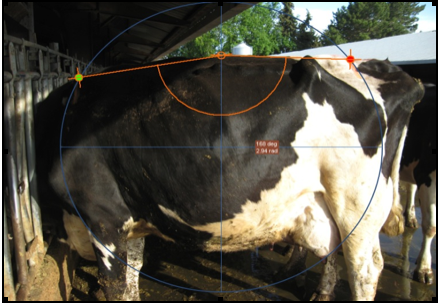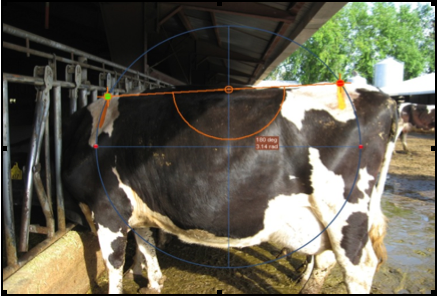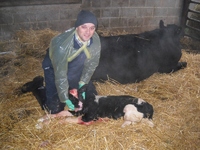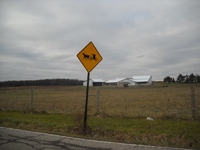Cows in a Pasture
 Friday, February 6, 2015 at 12:00PM
Friday, February 6, 2015 at 12:00PM Amy Pajcic, The Ohio State University
Creative Corner, Entry
 Acrylic painting on an 11"X 28" regular canvas
Acrylic painting on an 11"X 28" regular canvas
 Dairy cows,
Dairy cows,  Paintings,
Paintings,  acrylic painting,
acrylic painting,  ohio state in
ohio state in  Creative Corner
Creative Corner  Friday, February 6, 2015 at 12:00PM
Friday, February 6, 2015 at 12:00PM Amy Pajcic, The Ohio State University
Creative Corner, Entry
 Acrylic painting on an 11"X 28" regular canvas
Acrylic painting on an 11"X 28" regular canvas
 Share this Post | Comments Off
Share this Post | Comments Off  Dairy cows,
Dairy cows,  Paintings,
Paintings,  acrylic painting,
acrylic painting,  ohio state in
ohio state in  Creative Corner
Creative Corner  Wednesday, September 24, 2014 at 12:00PM
Wednesday, September 24, 2014 at 12:00PM Alex Sigmund, University of Georgia
Foot In Mouth, Honorable Mention
So I am by no means a “country boy,” but I also would not consider myself a “city boy” either. I’ve camped, hiked, and ridden horses, but I definitely have not dealt with cattle, sheep, and farming…EVER. With this history, I was incredibly ill prepared for a particular experience I would endure during my first year of veterinary school at UGA.
It was spring semester and that blasted anatomy class was finally over. We actually would get to touch live animals and it smelled and felt so…non-formaldehyde-y. With my sinuses clear, I was ready to learn and be “hands-on” with ruminants for the first time. I definitely did not realize just how “hands-on” I would be. But first off, goats are adorable and sheep are much bigger than they look on the movie Babe. Secondly, cows can squat.
 Share this Post | Comments Off
Share this Post | Comments Off  Dairy cows,
Dairy cows,  University of Georgia,
University of Georgia,  cow,
cow,  funny stories in
funny stories in  Foot in Mouth Disease
Foot in Mouth Disease  Wednesday, September 18, 2013 at 12:00PM
Wednesday, September 18, 2013 at 12:00PM Entry, Abstracts
Carlie Gordon, Washington State University
Background: Visual observation of an arched back in dairy cattle while they are standing and walking is one criterion for assessing lameness through locomotion scoring. However, observation of a back arch while cows are in stanchions is only variably associated with lameness. If the observation of back arch could be better defined, the sensitivity of this method might be improved. It was the purpose of this study to evaluate the degree of back arch that would differentiate lame from non-lame cows while in stanchions and assess if the back arch posture in the lock-up is a predictable observation for lameness.  This picture is showing a cow in lock up with an arched (concave) back. The cow in this picture has a back arch of 168 °, a deviation of 12° from a flat back as indicated by the orange line across her back.
This picture is showing a cow in lock up with an arched (concave) back. The cow in this picture has a back arch of 168 °, a deviation of 12° from a flat back as indicated by the orange line across her back.
Methods: Locomotion scores were collected for all lactating Holstein cows on one farm. Cows with scores of two or greater were used for this study. Eighteen cows received a locomotion score of ≥ 3 and 55 cows received a locomotion score of ≤ 2. Digital photographs of these cows while in stanchions and from videos as they exited the milking parlor were taken. Images were analyzed for the degree of back arch, “deviation from flat”, where a flat back was considered 180°. In addition, cows in one pen were observed 5 successive times while stanchioned to evaluate time in lockup effects on the presence of a back arch.
Results: The angle of deviation from cows during lockup was not associated with locomotion score. However, there was a trend for cows that were determined to have a locomotion score of ≥ 3 to have back angles that deviated further from 180 °. From the successive observations, back-arch was not a consistent observation but the proportion of observation time a cow was observed with a back arch was significantly greater for lame cows vs. non lame cows.  This picture is showing another cow in lockup. This cow has a straight back measuring 180 ° as indicated by the orange line across her back.
This picture is showing another cow in lockup. This cow has a straight back measuring 180 ° as indicated by the orange line across her back.
Conclusions: Our results indicate that the back arch observation, although inconsistently associated with locomotion scoring, could be used as a simple screening tool by veterinarians and dairy producers if frequent observations are made while the cows are stanchioned.
*Note: An organge paint stick was used to mark the withers and tail-head of each cow, pictures of each cow in lockup were then taken and at a later date a program called vistametrix was used to assess the the angle of each cow’s back
 Share this Post | Comments Off
Share this Post | Comments Off  Dairy cows,
Dairy cows,  Washington State University,
Washington State University,  abstract in
abstract in  Cases/Abstracts
Cases/Abstracts  Friday, November 2, 2012 at 06:00AM
Friday, November 2, 2012 at 06:00AM  veterinary student as they set off on their pursuit of their veterinary career. Each pre-vet and veterinary student is encouraged by, and hopes to one day become, just like the veterinarians of old that were central pillars in their communities. The doctors of 50, 60, 70 years ago imparted important, helpful knowledge, applied skills to save their neighbors beloved pet and/or farm, and were cornerstones of integrity and respect that helped build the veterinary profession into what it is today. I know firsthand of many of today’s students who aspire to join a small farming community and carry on these romantic visions of a life as a skilled, helpful and respected mixed animal veterinarian.
veterinary student as they set off on their pursuit of their veterinary career. Each pre-vet and veterinary student is encouraged by, and hopes to one day become, just like the veterinarians of old that were central pillars in their communities. The doctors of 50, 60, 70 years ago imparted important, helpful knowledge, applied skills to save their neighbors beloved pet and/or farm, and were cornerstones of integrity and respect that helped build the veterinary profession into what it is today. I know firsthand of many of today’s students who aspire to join a small farming community and carry on these romantic visions of a life as a skilled, helpful and respected mixed animal veterinarian.  with another veterinary extern, Dale, a student form The Ohio State University. Dale was kind enough to show me the ropes and give me a run-down as we hit the back roads in search of the dairy. From the time I arrived until my departure a short 11 days later, the work never really slowed down.
with another veterinary extern, Dale, a student form The Ohio State University. Dale was kind enough to show me the ropes and give me a run-down as we hit the back roads in search of the dairy. From the time I arrived until my departure a short 11 days later, the work never really slowed down.  Share this Post | Comments Off
Share this Post | Comments Off  Auburn University,
Auburn University,  Dairy cows,
Dairy cows,  Externship,
Externship,  James Herriot,
James Herriot,  Large Animal in
Large Animal in  Experiences
Experiences